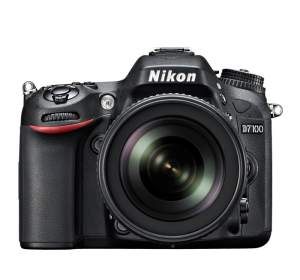Mid-February 2013 and here comes Nikon storming into the DSLR marketplace with the new D7100, the next step forward from the D7000, and the pack leader of Nikon DX-format digital cameras. The Nikon D7100 is obviously meant to appeal to photographers at various levels. It replaces the D7000 as the new first choice for many experienced amateurs and even serious enthusiasts who are ready to improve their skills beyond what they’ve learned on entry-level or other mid-level DSLRs. Professionals may find the D7100 to be an excellent second DSLR and the camera’s array of video features and capabilities will no doubt be appealing to many videographers.


Want to see reviews from other photographers? Read them HERE on Amazon
Although its only approximately 40% of the price of the Nikon D800, the company has decided to give the D7100 some of the D800’s technology. Nikon didn’t include an optical low pass filter (OLPF) on the D7100, which is also missing from the D800. The D7100 may have “just” a 24-MP sensor compared to the D800’s 36 megapixels, but photographers will more fully benefit from the high resolution of both sensors without an OLPF.
For videographers, Nikon gave the D7100 a number of video capabilities also found on the D800: output of uncompressed video, view footage on the LCD and an external monitor at the same time and a headphone jack to listen to the audio track. The D7100 is equipped with both built-in stereo microphones as well as a dedicated port for an external stereo mic. Videographers should also be attracted to spot white balance in Live View. Other video specs include 1080p Full-HD at 60/50/30/25/24 fps and 720p at as much as 60p to create professional-looking slow motion.
Nikon has also improved the D7100’s auto-focus system from its predecessor’s specs. The D7100’s 39-point system, with 9 cross-type points has been significantly upgraded on the D7100 to 51 points, 15 cross-type and a center point that operates at f/8. Although the D7100 has the same number of pixels in its RGB metering system as the D7000—2,016—the D7100 has Nikon’s 3D Matrix Metering II. Future testing will determine how much of an asset it is.
The new Nikon D7100 DSLR has been designed with a 1.3x crop mode, which results in a doubling of the focal length of lenses. With this camera, you may not have to buy quite as many lenses to cover most of the focal length range you’ll ever need. Be aware that selecting the 1.3x crop mode decreases the resolution to 15 megapixels, which is still more than adequate for many shooting situations. On the upside, burst mode increases from 6fps to 7fps, plus file sizes are smaller.
Physically, the new D7100’s dimensions are just a tad larger than the D7000 and it weighs just a bit less.
D7000: 5.2” x 4.1” x 3.0” (132mm x 103mm x 77mm), 24.3 oz. (690g)
D7100: 5.3” x 4.2” x 3.0” (135.5mm x 106.5mm x 76mm), 23.8 oz. (675g)
The D7100 has a 3.2-inch LCD and its 1.2-million-dot resolution is greater than found in the D800. The D7100 also includes a new OLED viewfinder with 100% coverage.
Nikon also made sure that the D7100 was ready for the world of connectivity and social media. Use this new DSLR in conjunction with the optional WU-1a Wireless Mobile Adapter to transfer images and video to compatible smartphones and tablets. To control this camera remotely, load your mobile device with Nikon’s free Wireless Mobile Utility and you transform either a smartphone or tablet into a Live View monitor.
The Nikon D7100 DX-Format DSLR is available for pre-order from Amazon for $1,196.95, body only, with an anticipated late-March 2013 shipping date.
This article about "Nikon D7100 DSLR Camera" was first published on our website here https://www.photographytalk.com/photography-equipment-reviews/3027-nikon-d7100-dslr-new-top-of-the-line-dx-format-digital-camera-should-intrigue-many-photographers
This article about "Nikon D7100 DSLR Camera" was first published on our website here https://www.photographytalk.com/photography-equipment-reviews/3027-nikon-d7100-dslr-new-top-of-the-line-dx-format-digital-camera-should-intrigue-many-photographers